An eyewitness report from a logistics company in Herat tells me the railway is “not finished yet”.
Iran
Herat railway operational?
I recently had an enquiry about the status of the project to build a railway from Iran to Herat – the e-mail came from from a novelist undertaking background research, which was a bit unusual, but potentially interesting.
The existing branch line to serve mines near Sangan is being extended from Khaf, crossing the Afghan border near Islam Qala to run to Herat. There have been various news reports about progress, although I have not yet found any conclusive evidence of work being underway, for instance any photographs showing earthworks.
As far as I am aware no opening has been announced, and given the strategic significance of this scheme I was reasonably sure that the Iranian authorities would have publicised it if it had been completed and opened.
However, Thomas Hammes, a senior military fellow at the US National Defense University’s Institute for National Strategic Studies, mentions the Herat railway as being functional in an NPR programme.
Can anyone confirm (or deny) this? Does anyone have any firm evidence of the line been complete (or even underway)?
Military Thinkers Answer Listeners’ Questions
What about Iran? Iran is in the formula. Its border with Afghanistan is rife with drug traffic. I understand from news sources in the U.S. that I read or listen to that almost all the drugs go across Iran before being distributed to Europe and the U.S.
Sally Williams
Berkeley, Calif.THOMAS HAMMES: Sally, you are correct. Iran is in the formula and must be part of the solution. During our initial invasion in 2001, the Iranians provided assistance against the Taliban. Since then, our relationship with Iran has deteriorated and their willingness to cooperate has, too. However, they have assisted the development of western Afghanistan.
The only functioning railroad in Afghanistan comes in from Iran to Herat. They have improved the roads, access to markets and provided reconstruction aid. They feel these actions are in their best interest. At the same time, they feel supporting some of the anti-government groups is also in their best interest.
Source: Military Thinkers Answer Listeners’ Questions, NPR, 2009-10-11
€3bn needed for Herat – Mazar-i-Sharif railway
ECO Urged to Invest in Iran-Afghanistan Railway Project
TEHRAN (FNA)- Iranian Minister of Road and Transportation Hamid Behbahani called on the Economic Cooperation Organization (ECO) to provide Afghanistan with 3 billion Euros in credit to accomplish a railway project linking the country to Iran.
“To finish Iran-Afghanistan railway project, ECO is needed to provide 3 billion Euros in credit for the construction of a 1,250 km-long railway segment between Herat and Mazar-e-Sharif (in Afghanistan),” Behbahani said in a ceremony to mark the arrival in Tehran of the first freight train ferrying cargo from Islamabad to Istanbul via Tehran.
[more]Source: Fars News Agency 2009-08-23
Pakistan – Iran – Turkey container train
The demonstration Islamabad – Zahedan – Istanbul train started its journey from Pakistan on 14 August 2009.
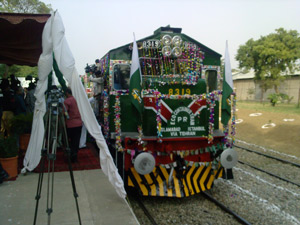
There are more details of the service (in Turkish) on the TCDD website. The photo is of a Pakistan Railways broad-gauge train. The containers are transhipped between gauges at Zahedan in Iran.
TCDD says the journey is 6566 km – other sources say about 6500 km with 1 900 km in Pakistan, 2 570 km in Iran and 2 036 km in Turkey – and the plan is to carry textile products, cotton, medical hand tools(?), toys, games and sporting goods westbound, with machinery and parts, chemical products, paper and paper products, cars spares and agricultural tools going eastbound.
According to PakTribune the journey “will take 15 days from Pakistan’s federal capital to the Turkish capital”, compared to “40-45 days from Karachi to a Turkish port” (do they really mean the Turkish capital, which is Ankara, or do they actually mean Istanbul, which people often mistakenly think is the capital?).
There is also a suggestion that Pakistan may join OTIF, which provides a common legal framework for international rail operations.
According to Iran’s Islamic Republic News Agency, regular services are expected to begin next year.
There are details of the background to the train in an article by Mohammad Mirzaei Kahagh, Director Transport & Communications at ECO, in the May 2009 issue of ECO Times. Despite the photos used in ECO Times, I don’t think Norfolk Southern or Norway’s Flåm railway are involved in the project!
Update: Barrie Hughes of the Welsh Highland Railway construction website has spotted that the tracklaying picture in the ECO Times article shows Cae Pawb mixed gauge crossing on the WHR/Cambrian Coast line in Porthmadog, Wales!
Update: The train reached Tehran on 23 August – Iran Daily has a photo of it. Director of Iran’s Railway Company Hassan Ziyari said the railroad is safer and more environmental friendly compared to the roadways and other transport modes. The duration of the entire journey can be reduced to 12 days in the future, he added, and voiced Iran’s preparedness for cooperating in new plans to expand rail networks of ECO members.
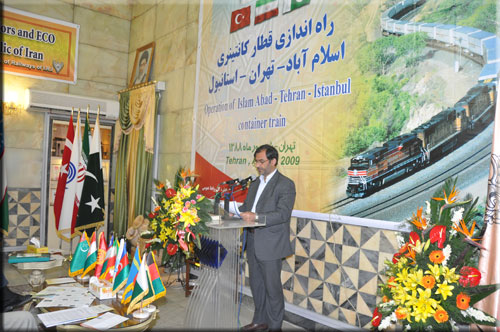
Update: It got to Turkey on 25 August – First train on Islamabad-Tehran-Istanbul railway arrives in Turkey
Update: It arrived at Haydarpasa station, Istanbul’s Asian station, on 28 August. 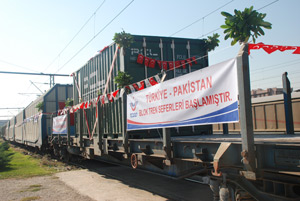
Gap in Britain to India rail route closed?
Various news reports suggest that the Bam – Zahedan railway line in Iran is now physically complete. While there is no direct connection to any of the Afghan rail projects, this railway is important for “joining the dots” on the global railway map, as it is the missing link between the Iranian railway network and Zahedan, terminus of the 5’6″ gauge line which runs into Iran from Pakistan.
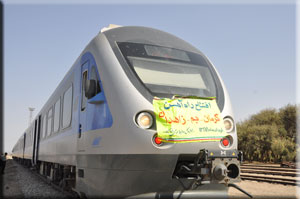
It seems there has been some kind of opening ceremony for the Bam – Zahedan line, but other articles suggest this might only have been held so that it was nominally finished before the recent Iranian elections were held.
Some reports suggest regular services might start on August 14 – which, whether by accident or design, is Pakistan’s Independence Day.
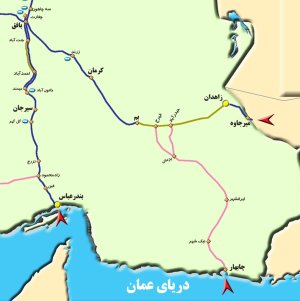
Until now Zahedan has been joined to the Indian subcontinent’s rail network, but not to the Iranian network. IRFCA has some history, and Dr John Stubbs wrote about the construction of the new line in the January 2007 issue of Railway Gazette International.
Via Google’s new Persian machine translation, I found this press release from Islamic Republic of Iran Railways. It gets a bit mangled in the translation (I don’t speak Persian), but is more or less understandable after some tidying up:
First passenger and goods trains to Zahedan station on the Kerman – Zahedan railroad
With the opening of the Kerman – Bam – Zahedan railway on 19/03/1388 [9 June 2009] southeast Asia was connected to Europe via Iran.
M. Hajian, Supervisor General at the Office of Public Relations of Islamic Republic of Iran Railways, said: The first cargo and passenger trains were welcomed into Zahedan station in the presence of the Deputy Managing Director of Islamic Republic of Iran Railway, [list of bigwigs which hasn’t quite survived translation], the Governor of Sistan & Baluchestan province and a group of regional VIPs.
Hajian added that the railway links Kerman – Bam – Zahedan and Sistan & Baluchestan province.
He said: This rail route will save energy, reduce road traffic, create employment in the east and south-east of the country and through economic development will reduce the causes of deprivation in the province of Sistan & Baluchestan and Kerman, and offer the possibility of bypassing the port to connect the port of Chabahar with north – south transit routes.
He added: “The railway has 11 bridges, the largest bridge 400 meters long, and 20 tunnels totalling 5320 meters.
Seat61 is probably the place to start if you are planning a journey from Britain to India by train (and two ferries – shortly to be one ferry when the Marmaray project in Istanbul is completed).
Iran’s Spending Spree in Afghanistan
A 20 May 2009 article from Time looks at Iran’s role in Afghanistan, including the Herat railway.
Some locals jokingly call Herat the “Dubai of Afghanistan.” The nickname is a stretch, but the mini-boom taking place in this commercial capital is borne out by 24-hour electricity and pothole-free streets where people wander without fear of the random violence that afflicts other urban centers in the country. Who gets the credit? Much of it goes to Iran, which lies less than a hundred miles to the west and is moving closer.
After completing a highway from its desert border, the Islamic Republic next door bankrolled an extension linking Herat city to Afghanistan’s remote northern provinces. Later this year, a host of Iranian-built schools, clinics and industrial parks around the city will be connected to the Iranian interior thanks to an $80 million railroad spur currently under construction. Homayoun Azizi, the head of Herat’s provincial council, says he’s grateful for the “huge impact” Iran has had in accelerating economic growth in the region, “But,” he asks, raising an eyebrow, “what are they doing beneath it all?”
More at Time
Third Regional Economic Cooperation Conference on Afghanistan
Islamabad Declaration
The delegates participating in the Third Regional Economic Cooperation Conference on Afghanistan having met in Islamabad on 13 – 14 May 2009:
…NOTE THAT
Transport, Trade, Energy Cooperation, Agricultural Cooperation, Capacity Building and Education, Border Management, Health, Counter Narcotics and Refugee Return and Reintegration are areas with considerable scope for mutually beneficial regional cooperation.Connectivity: Increased trade in the region will be facilitated by affording Afghanistan easy accessibility to the Sea, developing east-west and north-south corridors on the basis of mutual agreement, and further developing infrastructure links with Afghanistan and its neighbours.
Railway connection between Iran and Herat is already on going on the basis of a grant from the Government of Islamic Republic of Iran.
An 80 km railway link from Hairatan (on the Uzbekistan border) to Mazar-e-Sharif is considered a priority route for development. The planned link forms part of CAREC’s Transport and Trade Facilitation Strategy, and is in accordance with Afghanistan’s Railways Development Programme. The project will be developed with Asian Development Bank grant support.
…
HAVE DECIDED THAT
…
4. High priority will be accorded, in terms of resource allocation and political commitment to the following set of practical short-term projects of benefit to Afghanistan and the region:
a. Concluding negotiations of the Afghanistan Pakistan Trade and Transit Agreement before the end of 2009, as agreed earlier this month in Washington, DC.
b. Extension of rail link from Chaman to Kandahar.
c. In addition, the European Commission will conduct a pre-feasibility study of railways across Afghanistan linking major destinations within Afghanistan and its neigbours.
…
Read in full on the Ministry of Foreign Affairswebsite.
(thanks to Michael G Erickson for sending me a link)
German firms to use Herat railway?
A German firm is reported to be negotiating to use the future railway from Iran to Herat to suply NATO.
German Army spokesman confirms negotiations with Iranian Pvt Firms
Berlin, April 2, IRNA – A spokesman of German Army here Wednesday confirmed in an interview with IRNA representatives of Iranian private firms negotiated with Germans regarding transferring some non-military facilities for German forces situated in Afghanistan.
The spokesman who spoke on condition of anonymity said, “The German sides negotiating with Iran are representatives of private firms that provide foodstuff and fuel for the German forces serving at NATO units in Afghanistan.
He added, “These companies are after finding alternative routs for Pakistan to forward those goods to Afghanistan thorough it.”
…
According to him, those companies have considered using the Chabahar-Zaranj road, or the Tehran-Harat railroad to transfer their logistical, non-military facilities to Afghanistan.
Source: IRNA 2009-04-02
Iran to Afghanistan railway completed ‘in the next 5 years’
Afghan website Quqnoos reports on the Iran — Herat railway construction project. There is a photograph of some railway track, but it could be a stock picture rather than evidence of the work being underway.
Plans to extend the line from Herat to serve the existing railheads are mentioned.
Afghanistan’s railway project which will connect Shirkhan harbor with the western province of Herat will cost $2 billion.
The project which is planned to be completed in the next five years will connect Central Asia with Iran via Afghanistan.
Construction work on the project, from Herat to Iran, has already started. The design of the rest of the railway network from Herat to the Shirkhan commercial transit way is also in late planning stage.
The railway network which will be about 1200 km long will connect Afghanistan’s Shirkhan, Hairatan, Aqina and Torghondi commercial highways with the commercial harbors in the central Asian countries.
…
Meanwhile the media in Tajikistan have reported that work has begun on a railway network which will link Klokhabad with Panjpayan, on the border with Afghanistan.
Source: Quqnoos.com 2009-01-19
Iran building rail links to Iraq and Afghanistan
Network expansion is in full swing is an article about the Iranian rail network in the January 2009 issue of Railway Gazette International.
The author is railway consultant David Brice, who has worked on transport projects in Afghanistan, including at the Hayratan terminal.
Work is currently well in hand on extension of RAI’s Torbat – Sangan iron ore line across the border to Herat in Afghanistan (RG 1.08 p55). Whilst perhaps not a major development in terms of generating traffic, this line certainly has major political implications. Largely financed by the Iranian government, it will constitute the first major standard-gauge line in Afghanistan.
A further extension to Sher Khan Bandar serving the northeast of Afghanistan is currently under investigation, and on November 23 2008 the Asian Development Bank announced that a protocol had been signed highlighting the importance of developing rail links from Herat through Mazar-i-Sharif as far as the current Uzbekistan Railways railhead at Hayratan, reached by a 1 520 mm gauge line from Termez. The Afghan government has requested technical and financial assistance from ADB for a pre-feasibility study.
A proposed extension of this route beyond Sher Khan Bandar along the Wakhan Corridor, albeit through challenging terrain, could complete a direct connection from Iran to the rapidly expanding Chinese rail network, creating a standard-gauge through route between Europe and China.
[…]Iran – Iraq. Two links to Iraq are in hand, one from Khorramshahr to the port of Basra, and the other from Arak via Kermanshah to the Iraqi border at Kosrayi. This will cater for substantial flows of pilgrimage traffic once the political situation has normalised.
Source: Railway Gazette International